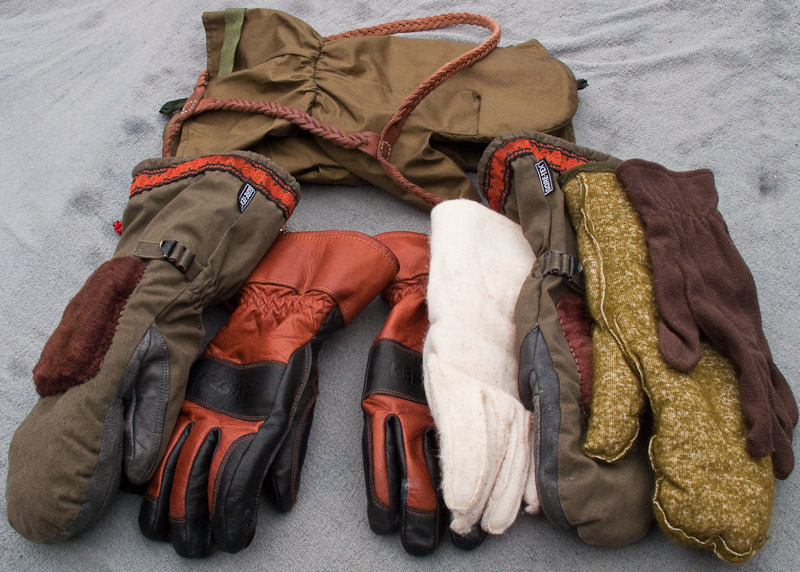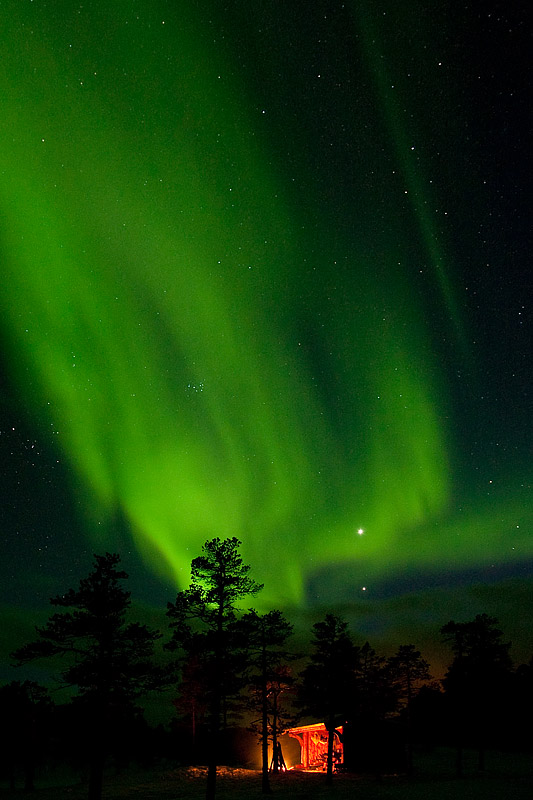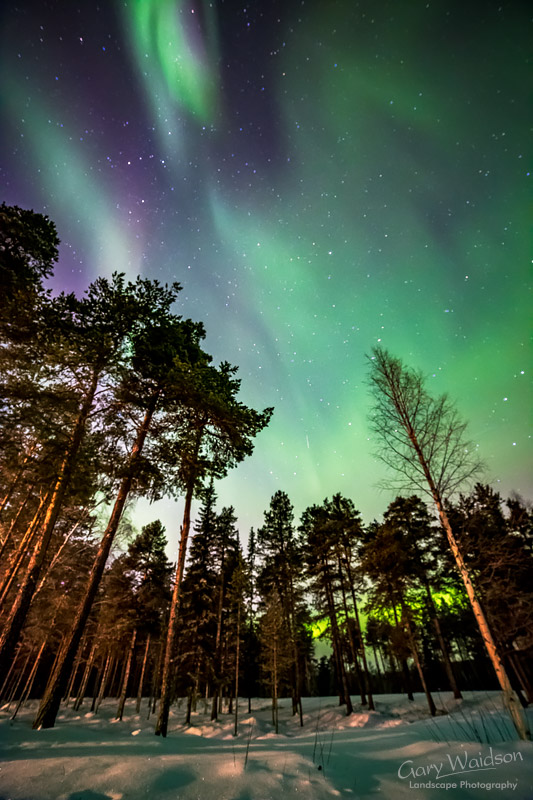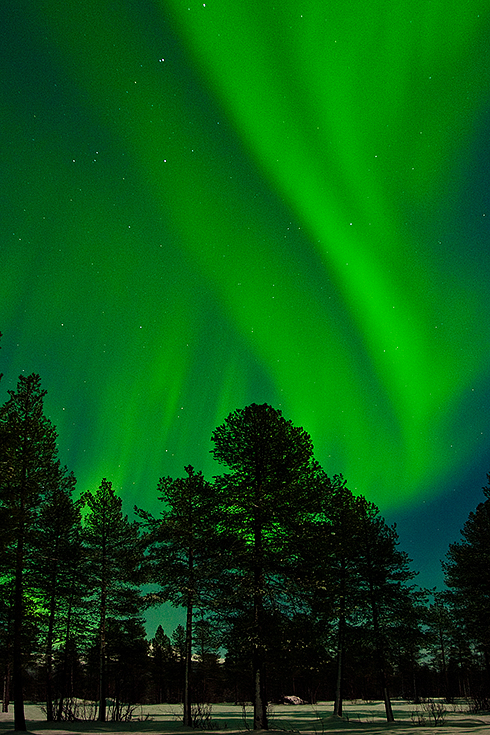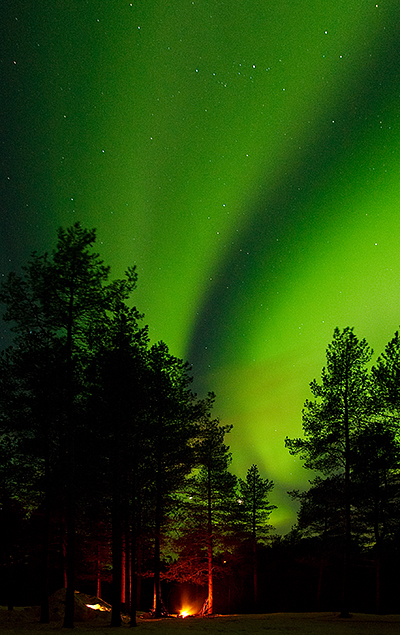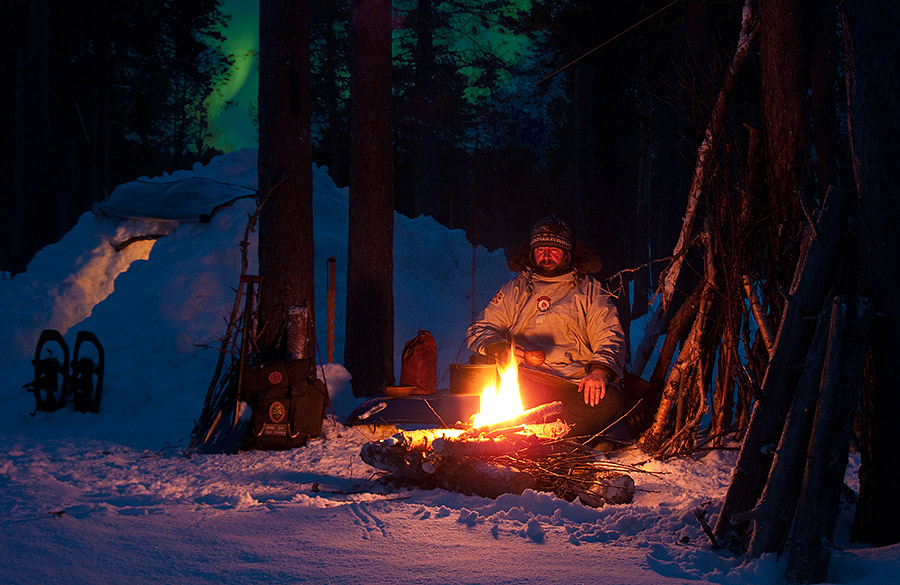
Having just dusted my gear off in preparation for another trip North this winter I realised I had never posted up anything about photography in very cold conditions.
If you check the specifications of almost all digital cameras you will find an operating temperature range that suggest than sub zero photography is not a good idea. A quick trawl of the internet would seem to confirm this view with often conflicting information and horror stories of expensive gear reduced to junk by the conditions. I’m not going to tell you that these issues are unimportant. There is a real risk of damaging your photographic equipment if you do not treat it with respect and care but as with many things, the specifications are only a part of the story.
The first challenge is power. Batteries of any kind do not perform at their best when cold. Some are worse than others but this is a universal problem for photographers.
The next challenge is the effect of the cold on the camera itself. Most worrying are the stories of LCD displays freezing and being permanently damaged. Information on this matter seems scarce and confused but is discouraging.
The most helpful information I could find suggested that a standard TFT display like those found in most cameras, had an operating range between -10°c and +70°c (14°f to 158°f)and could be stored safely between -30/-20°c and +80°c. (-22°f/-4°f and 176°f) Presumably the 10°c difference in the minimum storage temperature is down to variations in manufacturer which there is no way to ascertain which might apply so it’s best to assume that -20°c (-4°f) is the lowest practical limit before you might expect damage to your camera screen.
Another less publicised effect of the cold is that the lubricants used in delicate mechanisms can thicken or even solidify. Again, my research on this matter has been inconclusive and often conflicting so far. Manufacturers are often quite unhelpful frankly and unprepared to state exactly what the real limitations of their equipment are.
All it all, it seems that the best course of action is to prevent the camera and it’s batteries from getting too cold.
The most usual solution that is suggested is to keep your camera inside your clothing and the batteries warm in our pockets so they can be swapped with the cooler ones in the camera. This approach works well but there is a risk that a cold camera, brought into the warm, moist atmosphere of our clothing will attract condensation which can be very damaging to any electrical device. Indeed this is also a major consideration when bringing your photographic equipment from the cold to any warm environment.
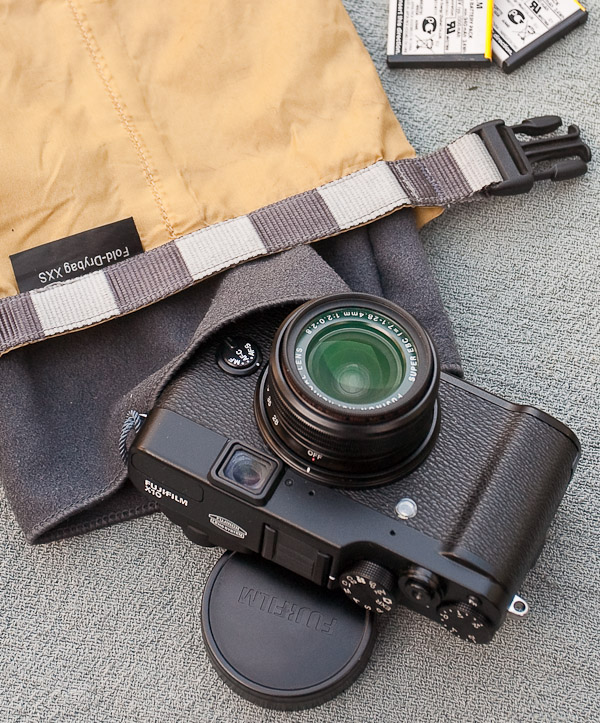
Dry bags are very useful when dealing with condensation problems. The only problems I have experienced with dry bags is that the air trapped inside them in a warm space can contain some moisture which causes a small amount of condensation on the inside of the bag when moving to cold conditions.
To alleviate this problem I line my bags with a secondary bag made from the highly absorbent micro fibre material that is used to make travel towels for backpackers. As a bonus, this also provides some measure of extra padding and protection from the physical rigours of travel and packing.
My routine then is to store the camera in this combination of bags and try to keep it away from the worst of the cold. A compact camera can be kept inside your clothing for much of the time but a large one presents more problems of course. I usually keep mine wrapped in as much spare clothing as I have available in my baggage and keep it in a sheltered place when not in use.
Another useful item to carry with you is some small form of hand warmer. I often use the small disposable type that I can tape around the battery compartment of the camera when it is in use and this is packed in the dry bags, covering the camera display for good measure. A handy trick to keep your camera a bit warmer when packed away is to to put a spare water bottle full of hot water into your baggage as well. This will help to prevent the temperature dropping to dangerous levels and also leave you some liquid water ready for the next round of snowball soup.
When using the camera I keep a couple of batteries in my trouser pocket and swap them whenever the camera power indicator drops a bar or so. Being cold will not discharge the battery it just makes it harder to draw the power, so I keep a store of charged batteries in my baggage that can replace my working set when they are exhausted.
So far, I have not found an effective, practical method of charging these batteries in the field so I use whatever opportunity I get to use mains power, a generator or a vehicle for the job.
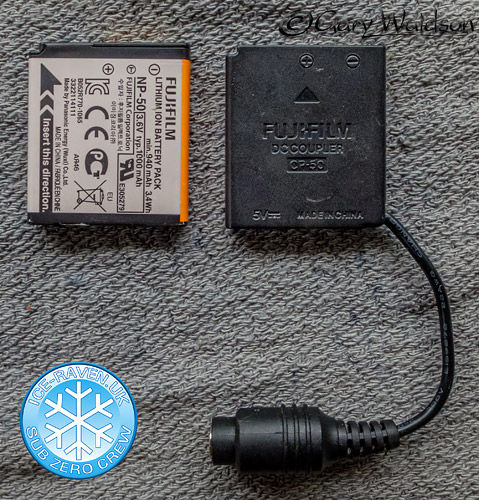
This brings me on to another solution which is based around the mains adapter units that are available for some cameras. These often connect through a battery coupler which is like a dummy battery with a lead which connects to the AC/DC power brick. The AC/DC converter supplies the coupler with DC power so all we need to do is supply DC power of the correct voltage to run the camera.
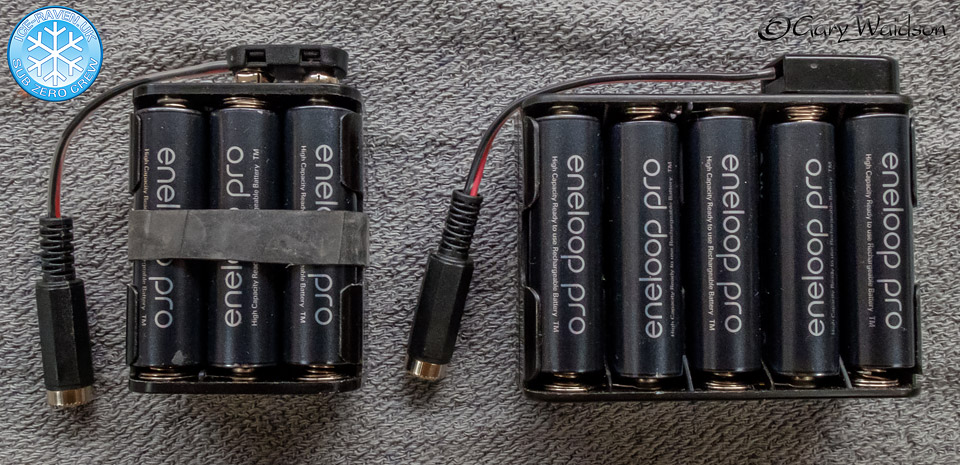
This gives us the opportunity to have a separate power pack inside our clothing where it is warm, attached to the camera with an connecting lead. The easiest solution is to use AA batteries in a simple holder and use the right number of cells to provide the voltage required.
That certainly works but depending on the camera there may be a fairly limited voltage range that it will work with. If camera is designed to work with a battery providing 3.6v like my Fuji for example then it may work a volt or two above and maybe a volt below that but not much more.
If you use four standard 1.5v AA cells that should in theory provide 6v but a fresh cell could provide 1.6v pushing your combined pack to 6.4v, almost twice what the camera is designed for.
Looking at the AC/DC converter will give you a clue how far it is safe to push things. If you look at the Fuji DC Coupler pictured above for example, you can see it is rated for 5v . Rechargeable AA cells usually provide 1.2 - 1.3v so four of those is closer to the mark but inevitably as the power drops we are going to hit the camera's lower power rating. the point at which it stops working.
I have used this method and it does work but I don’t think it is the most efficient.
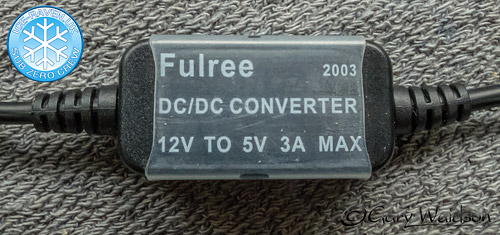
What I prefer to do is use a larger pack of batteries providing somewhere in the region of 12v and then use a DC/DC converter to drop the voltage to the working level.
The advantage of that is that most converters are designed to work with a range of input voltages but provide a fairly stable output voltage.
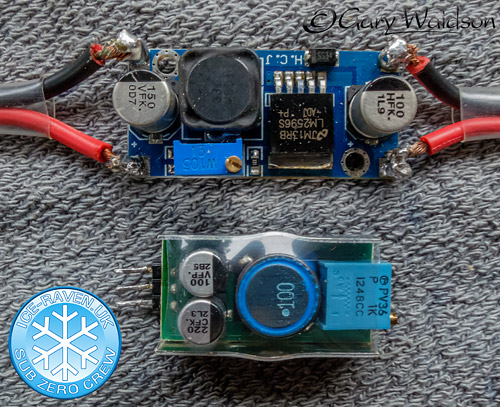
In the case of the Fuji camera that runs on 5v that was fairly easy. Cars run on 12v and USB connectors provide 5v which means lots of manufacturers make widgets that will do the job. I found a nice neat unit that is fitted in-line so I just swapped the USB output socket lead for a lead that connected to the DC Coupler. Job Done.
My Canon cameras needed a bit more power. 8.6v according to the spec. I couldn’t find anything ready made so I ordered an adjustable “Buck Converter” like the ones you can see here.
The first one I bought from America, you can see that at the bottom. It cost a fortune and then had crippling import duties and admin charges on top of that which doubled the price.
The unit in the top of the picture was from China. I bought a pack of ten for less than the cost of the American one. They do exactly the same job.
You can see that I’m not an expert with a soldering iron but four connection which are clearly labelled and you are ready to go. I put mine in a plastic project box and added a switch for convenience and that fits into a case which hangs over my shoulder under my parka with a powerful rechargeable Lithium Polymer (LiPo) power pack in it.
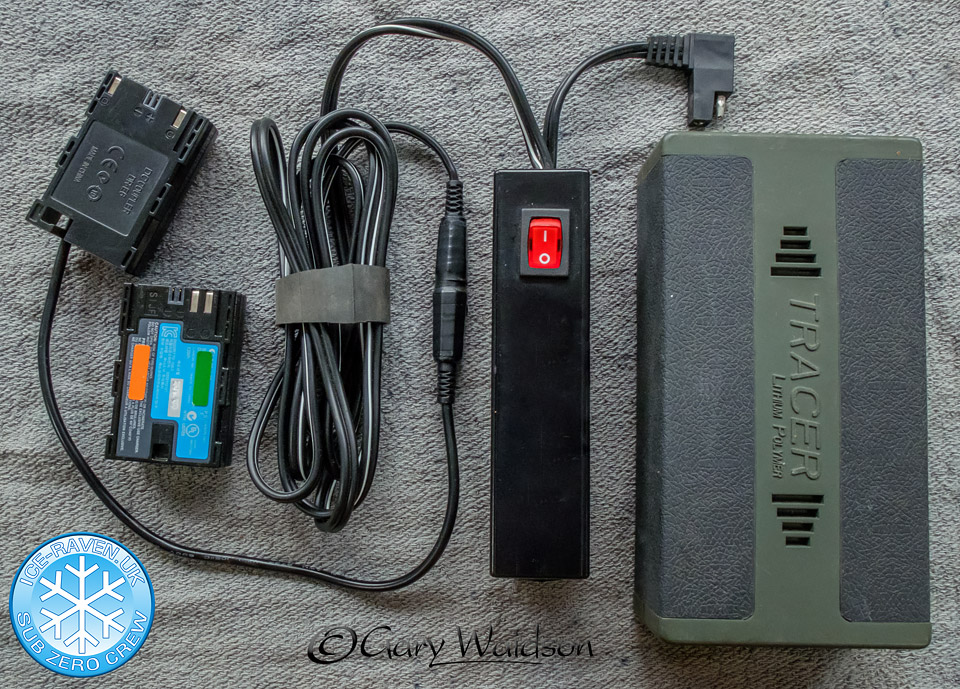
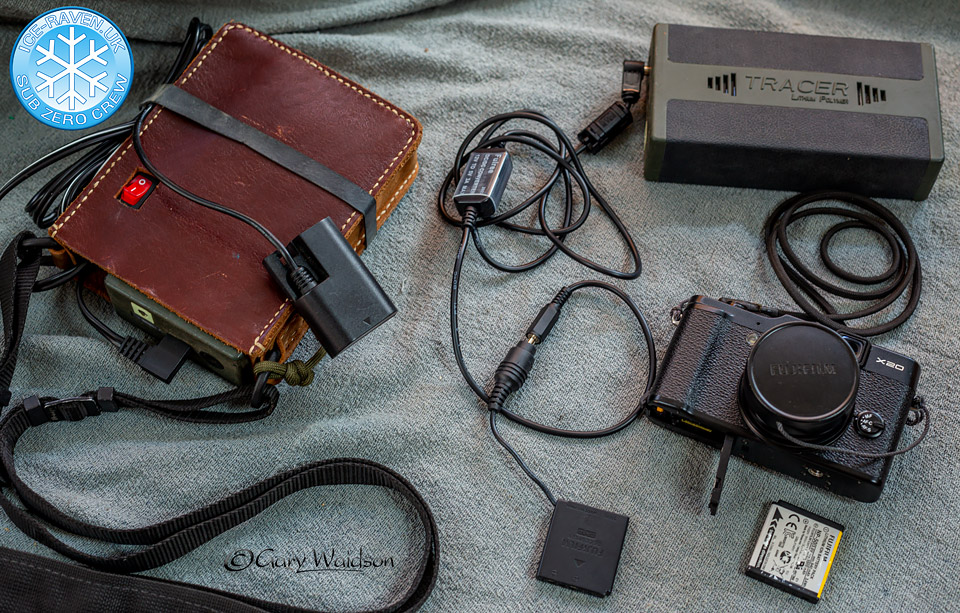
So far it is working well and the capacity of the pack far out weighs the additional bulk in your pocket.
I also carry a couple of ten AA battery packs with good quality nickel metal hydride(NiMH) cells giving me some reserve power if I need it but being splitable for flashlights or other electrical equipment if required.
The lead is robust and long enough to be threaded through my outer clothing to a warm pocket within. Both LiPo and NiMH can provide their power fairly constantly down to -10°c and carry on working down to -20°c so kept inside the clothing there should be no problem.
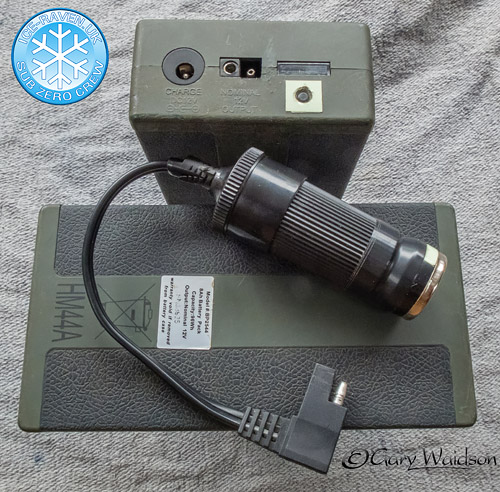
The LiPo packs I use have a proprietary power connector which, though reliable, is a pain in the butt when it comes to making leads.
Another thing it came with was a car cigarette lighter adaptor which has to be one of the most unreliable ways to connect anything but a cigarette lighter. I have converted mine by plugging a USB adaptor into it so that I can use the power pack to charge USB devices while off grid. You will note that I’ve taped it into position to make it a bit more reliable.
As a tip though, I discovered that the charge socket which is a standard 5.5mm connector can also be used as a power output.
Last edited:

